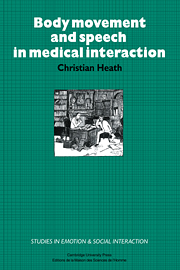Book contents
- Frontmatter
- Contents
- Preface
- The transcription system
- 1 Video analysis: interactional coordination in movement and speech
- 2 The display of recipiency and the beginning of the consultation
- 3 Maintaining involvement in the consultation
- 4 Forms of participation
- 5 The physical examination
- 6 Taking leave of the doctor
- 7 Postscript: the use of medical records and computers during the consultation
- Notes
- References
- Index
3 - Maintaining involvement in the consultation
Published online by Cambridge University Press: 19 January 2010
- Frontmatter
- Contents
- Preface
- The transcription system
- 1 Video analysis: interactional coordination in movement and speech
- 2 The display of recipiency and the beginning of the consultation
- 3 Maintaining involvement in the consultation
- 4 Forms of participation
- 5 The physical examination
- 6 Taking leave of the doctor
- 7 Postscript: the use of medical records and computers during the consultation
- Notes
- References
- Index
Summary
The task of becoming spontaneously involved in something when it is a duty to oneself or others to do so, is a ticklish thing, as we all know from experience with dull chores or threatening ones. The individual's actions must happen to satisfy his involvement obligations, but in a certain sense he cannot act in order to satisfy these obligations, for such an effort would require him to shift his attention from the topic of conversation to the problem of being spontaneously involved in it. Here, in a component of non-rational impulsiveness-not only tolerated but actually demanded we find an important way in which the interactional order differs from other kinds of social order.
Goffman 1967/1972, p. 155There is nothing so brutually shocking, nor so little forgiven, as a seeming inattention to the person who is speaking to you: and I have known many a man knocked down for (in my opinion) a much slighter provocation than that shocking inattention which I mean. I have seen many people who, while you are speaking to them, instead of looking at, and attending you, fix their eyes upon the ceiling, or some other part of the room, look out the window, play with a dog, twirl their snuff box, or pick their nose. […]
- Type
- Chapter
- Information
- Body Movement and Speech in Medical Interaction , pp. 49 - 75Publisher: Cambridge University PressPrint publication year: 1986



